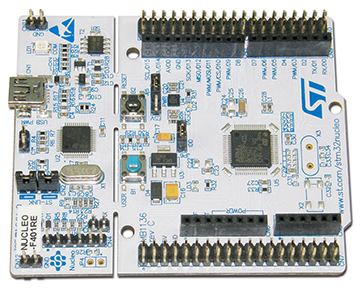

This parameter must be a value of RCC_PLLP_Clock_Divider */ Uint32_t PLLP /*!< PLLP: Division factor for main system clock (SYSCLK). This parameter must be a number between Min_Data = 192 and Max_Data = 432 */ Uint32_t PLLN /*!< PLLN: Multiplication factor for PLL VCO output clock. This parameter must be a number between Min_Data = 0 and Max_Data = 63 */ Uint32_t PLLM /*!< PLLM: Division factor for PLL VCO input clock.

This parameter must be a value of RCC_PLL_Clock_Source */ Uint32_t PLLSource /*!< RCC_PLLSource: PLL entry clock source. This parameter can be a value of RCC_PLL_Config */ Uint32_t PLLState /*!< The new state of the PLL. *note that RCC_PLLInitTypeDef in stm32f4xx_hal_RCC_ex.h RCC_PLL_ON PLLSource=RCC_PLLCFGR_PLLSRC_HSE PLLM=8 PLLN=336 PLLP=2 PLLQ=7 } Rcc_systemclock=HAL_RCC_GetSysClockFreq() Uint32_t rcc_systemclock,SystemCore_Clock to check the value of system clock by stm studioĮnabling high speed the external clock crystal clock
Nucleo f401re clion how to#
PA5, PA6, and PA7 are connected to LD_1, LD_2, and LD_3 as shown in the next table.I am just knowing how to deal with stm(nucleo board f401re ) i use COIDE and i follow all instructions of hse enable to active stm32f401 at 84MHZ oscillator i check the board too for sure that SB55 OFF and SB54 ON & SB16 and SB50 ON but it give me also 16MHz system clock could any one told me what is wrong in my code This board contains the STM32F401RE, a 32-bit microcontroller with an ARM Cortex-M4 core. The Nucleo-F401RE board is used for all the examples.

For example, L holds a semaphore that H must wait to continue executing. In this post, a Segger J-Link Edu probe and Percepio TraceAnalyzer are used.Ī common bug in RTOS-based applications is priority inversion, that occurs when a high priority task H is indirectly preempted by a low priority task L. Frequently you must employ advanced debugging tools allowing the examination of the system’s inner behavior very closely, with minimal intromission. Printing messages as a debugging tool is very limited and intrusive. Last but not least, the parallel nature of the RTOS-based applications makes the code debugging a difficult task. Also, the embedded systems developer needs to learn how the use of the RTOS itself, like its configuration and the API functions for controlling tasks and communicating between them. Developers should start by using rate monotonic scheduling (RMS) to get a general feel for whether their periodic tasks can be scheduled successfully. … Continue reading. Runtime priorities and periods must be assigned to tasks: it is not immediately obvious what the best solution is Selecting task priorities can be a challenge. An RTOS-based application uses tasks running in parallel that are interacting and competing for resources. However, learning to use an RTOS is not easy.
Nucleo f401re clion software#
In addition, a RTOS enables easier software modularization and reusability, thus improving software development productivity as well as improved system reliability. An RTOS typically provides a hard real time response, providing a fast, highly deterministic reaction to external events. A real-time operating system (RTOS) provides:įacilitating the creation of complex applications.


 0 kommentar(er)
0 kommentar(er)
